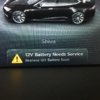The C&D DCS-33IT battery Tesla is now using (red case) is a high quality AGM battery. They used to use these crappy grey ones.
I doubt you'll do better than the C&D unless you go with Lithium.
Also, if you're about to take a trip and you're worried about the 12v, just bring along a 12v jump-pack, then you won't be stranded. The Model S jumps just like an ICE car, all you need is to pop the nosecone off and there are 2 terminals right there. If your car is dead or won't close contactors, just apply an external 12v source to the jump posts and then step on the brake and it'll fire up.
The only thing that could leave you truly stranded is a DC-DC converter failure. If this happens, then the 12v system will stop getting power from the main (traction) battery and start draining the small 12v. This will quickly deplete it and the car will die. You will get a "pull over" message if this happens. The only way I could think of to avoid a tow at that point would be to buy a large 12v battery, such as the kind a semi uses and throw it in the frunk. Connect it to the jump posts and the car will start and drive as long as it holds out. Turn off all non-essential loads, such as climate control, lights, etc. Dim the screen all the way down.
Just back of the napkin calculations show that a 250 amp-hour truck battery should get you at least 6-8 hours of driving (single motor car) if you conserve 12v power.
The way the system works in the Model S is the 12v voltage is monitored when the car is asleep. If the 12v gets low, the car wakes up and closes it's main battery contactor to recharge the 12v battery. This in "Tesla speak" is called support mode. Once the 12v is topped off, the car goes back to sleep. This is where the "vampire" load comes from. If the car detects that it's entering support too often, or that it can't complete charging the 12v during support mode, you will get the alert message. (also the car will call Tesla and let them know too)
Not a catastrophe as long as there is at least a few % in the main pack, you will just see an increased vampire loss as support mode starts running longer and longer.
Very rarely is there a 12v battery failure without warning, catching the support mode off-guard. This can result in a "dead" car needing a jump.
Also, note, unless the DC-DC fails, the car will not "die" on the road as long as you keep it on. You can literally yank the 12v right out of the car and the car will keep going forever as long as you don't let it go to sleep.



